Vahdat Hall
The Vahdat Hall (Persian: تالار وحدت – Tālār e Vahdat means "Unity Hall"), formerly the Roudaki Hall (Persian: تالار رودکی – Tālār-e Rudaki),[2] is a performing arts complex in Tehran, Iran.
| Vahdat Hall / Roudaki Hall | |
|---|---|
تالار رودکی / تالار وحدت Tālār-e Vahdat / Tālār e Rudaki | |
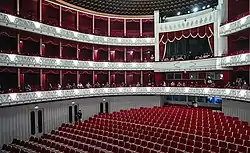 | |
| General information | |
| Type | Opera House |
| Location | Shahriyar Street, Hafez street corner, Tehran, Iran |
| Construction started | 1957 |
| Completed | 1967 |
| Inaugurated | October 26, 1967 |
| Technical details | |
| Floor area | 92,000 m2 (990,280 sq ft)[1] |
| Design and construction | |
| Architect(s) | Eugene Aftandilian |
History
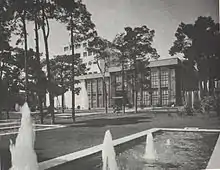
Around the 1950s and 1970s, the Iranian national stage had become the most famous performing scene for known international artists and troupes in West Asia,[3] with the Vahdat Hall constructed in the capital of the country to function as the national stage for opera and ballet performances.
Construction
The complex was designed by architect Eugene Aftandilian, influenced by the Vienna State Opera, and was constructed during a period of ten years starting in 1957.[1] It was equipped with the latest lighting and sound system technologies of the time, with revolving and moving stages. The main stage consists of three different levels (podiums). The auditorium seats 1200 and has two tiers of boxes and balconies. The venue was fully supplied by Siemens Electrics. The main curtain in proscenium has a motif of a phoenix rising from the ashes, with the style of Persian miniature.
Just before the completion of Tehran's new opera house, Nejad Ahmadzadeh, artistic director of the Iranian National Ballet Company, was sent by the Ministry of Culture and Arts to the United States to visit their opera houses and study administrative, organizational, and technical constructions of American opera establishments that were deemed to be the most modern in the West. At his return, he was appointed as manager of the upcoming opera house, and established the technical, administrative, and artistic sections of the Vahdat Hall. The constructions of the hall were eventually completed in 1967.
Inauguration
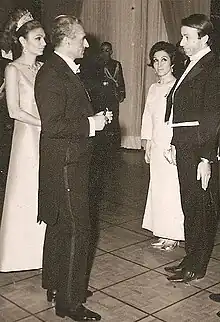
As part of the Shah's White Revolution, the Vahdat Hall of Tehran was constructed to function as the national stage for music, opera, and ballet, and was inaugurated by former king Mohammad Reza Pahlavi on October 26, 1967, with the performance of The Rustic Festival, the first Persian opera, composed by Ahmad Pejman. Two weeks of full house performances by international ensembles marked the coronation festivities. Numerous orchestras, opera singers, and dance companies were invited to perform for the occasion.
The hall is home to the Tehran Symphony Orchestra, Tehran Opera Orchestra, and the Iranian National Ballet Company. Other troupes, ensembles, and artists, such as the Iranian folk dancers, also used the stage of the Vahdat Hall for their presentations.
Productions and guest presentations
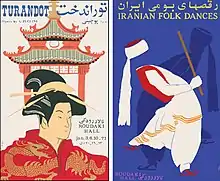
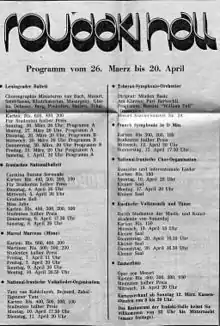

Before the 1979 Revolution
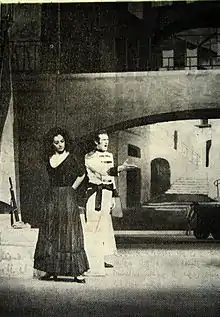
Ballet
- Bijan and Manijeh (1975)
- La Bayadère (Season 1972–73)
- Myth of the Creation (1971)
- Nutcracker (1971)
- Bolero
- The Firebird (1967)
- Carmina Burana
- The Witch Boy
- The Fountain of Bakhchisarai (Season 73–74)
- Swan Lake (Season 1971–72)
- Petroushka
- Les Sylphides
- Giselle (Season 1970–71)
- La Fille Mal Gardée
- Romeo and Juliet (1968)
- Scheherazade
- Coppélia (Season 1972–72)
- Miss Julie
- Cinderella (1969)
- Serenade
- The Sleeping Beauty (1978)
Opera
- The Rustic Festival 1967
- Hero of Sahand (Delavareh Sahand)1968
- Pardis and Parisa
- La traviata
- Orfeo ed Euridice
- Madama Butterfly
- Turandot (1971)
- La bohème
- Carmen
- Nabucco (1976)
- Falstaff (1977)
- Werther (1977)
- Die Zauberflöte (1978)
Various national and international festivals were organized at the Roudaki Hall, including:
- International Film Festival
- Ballet and Dance Festival
- Folk Dance Festival
- Annual Festival of Culture and Arts
Since the inauguration of the Roudaki Hall in 1967 until the last stagings in the fall season of 1978, world famous music, opera, and dance artists visited Iran to stage their works. Presentations of the guest artists and ensembles included:
Guest ballet companies
- Kirov Ballet (Mariinsky Ballet)
- The Igor Moiseyev Ballet
- Le Grand Ballet Classique de France
- Antonio Gades Flamenco Ensemble
- Stuttgart Ballet
- Berliner Ballett
- Le Ballet de XXe Siécle (Ballet of the 20th Century)
- Nederlands Dans Theater (1977)
Guest ballet artists (dancers / choreographers)
- Rudolf Nureyev
- Margot Fonteyn
- Robert de Warren
- Liane Daydé
- William Dollar
- John Cranko
- Marcia Haydée
- Richard Cragun
- Robert Urazgildiev
- Maurice Béjart
- Alvin Ailey
- Jiri Kylian
Guest opera singers
Ingrid Rezai Anayatolla Rezai Monier Vaquilli
Guest music ensembles
Guest musicians / conductors
Other presentations
- Marcel Marceau, the pantomime artist (1978)
After the 1979 Revolution
Roudaki Hall has remained the most important venue of Tehran. Concerts of traditional Iranian music, pop, and classical symphonic and orchestral music are staged regularly. After 1979 Revolution, Poetry Council at Office of Poetry and Music of Ministry of culture was formed in Rudaki Hall to preserve music in Iran. Some famous poets worked there, like: Mehrdad Avesta, Ahmad NikTalab (after him, Babak Niktalab), Mohammad Ali Bahmani,[4] Moshfegh Kashani.[5]
Among the presentations after the 1979 Revolution are:
Concerts
- Vasl-e-Yar Ensemble
- Choir of Gorgin Mousissian
- Tehran Symphony Orchestra
- Nour Ensemble
- Bob Belden's ANIMATION
Artists
Events
- International Fajr Film Festival
- International Fajr Theater Festival
- Tehran Art Expo.[6]

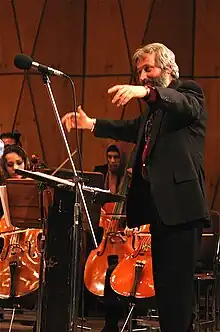
Guest presentation
- Dundee Repertory Theater
Specifications

Total capacity of the hall is about 750 seats; with 500 seats in the main hall, and 250 seats in the balconies.
Stage Dimensions
- Proscenium opening: 12m
- Stage depth: 35m
- From hall's end to the proscenium opening: 23.75m
- Stage height: 28m
- Deck height: 85 cm
- Proscenium opening height: 7m
- Forestage: 2.70m
Operational and artistic directors
General directors
- Hamed Rowhani (1967–?)
- Sadi Hassani (in between the other two)
- Abedin Zanganeh (?–1979)
- ? (1979–?) (after the 1979 Revolution and before the re-organization of the hall in 2003)
Following a legislation from the Parliament of Iran in 2003, the operation management of the hall was reorganized. A new non-governmental public foundation was established in order to be in charge of the Roudaki Hall. The CEOs of Roudaki Foundation, responsible for the operation of Roudaki Hall have been:
- Mehdi Massoudshahi (2003–2008)
- Ali Asghar Amirnia (2008–2010)
- Hossein Parsaee (2010–2011)
- Alireza Hosseini (2011–2013)
- Hossein Seyfi (2013–2014)
- Bahram Jamali (2014–2016)
- Ali Akbar Safipour (2016–2019)
- Mehdi Afzali (2019–2022)
- Majid Zeinolabedin (2022–2023)
- Mehdi Salem (2023–present)
Ballet directors
- Nejad Ahmadzadeh (1967–1976)
- The Iranian National Ballet Company was founded in 1958 and moved to the Roudaki Hall in 1967.
- Ali Pourfarrokh (1976–1979) held the position until disbanding of the Iranian National Ballet.
Music directors
- Farhad Meshkat
- Alexander Rahbari[8] (2015–2016)
- Shahrdad Rouhani[9] (2016–2020)
- Nassir Heidarian-Rasty[10] (2022–present)
Gallery
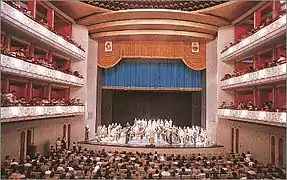 Auditorium of the Hall.
Auditorium of the Hall.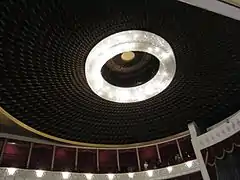 The ceiling of the Hall.
The ceiling of the Hall.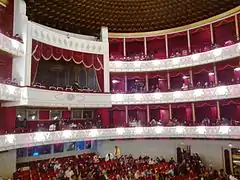 Eastern balconies and the special position.
Eastern balconies and the special position.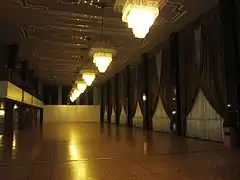 Second floor of the complex.
Second floor of the complex. Outside view of the complex.
Outside view of the complex.
References
- Citations
- CAOI: Tehran Vahdat Hall
- Don Rubin, ed. (1998), The World Encyclopedia of Contemporary Theatre, London: Routledge, ISBN 0415059283, OCLC 32008932
- Kiann, Nima (2015). The History of Ballet in Iran. Wiesbaden: Reichert Publishingi
- "محمدعلی بهمنی", ویکیپدیا، دانشنامهٔ آزاد (in Persian), 2020-11-10, retrieved 2020-12-19
- "مشفق کاشانی", ویکیپدیا، دانشنامهٔ آزاد (in Persian), 2020-06-24, retrieved 2020-12-19
- "Tehran Art Expo to open on June 17". Tehran Times. June 16, 2012. Archived from the original on November 6, 2013.
- Notes on Roudaki Hall in Tehran, Iran – A Celebration of Opera by Liliana Osses Adams
- https://slippedisc.com/2016/03/bitterest-day-of-my-life-maestro-quits-tehran/
- https://www.tehrantimes.com/news/448153/Conductor-of-Tehran-Symphony-Orchestra-Shahrdad-Rohani-quits
- https://www.honaronline.ir/Section-music-5/175317-nasir-heidarian-takes-baton-in-tehran-symphony-orchestra
- Bibliography
- Fajr Theater Festival
- Kiann, Nima. (2000). Persian Dance and Its Forgotten History
- Kiann, Nima (2015). The History of Ballet in Iran. Wiesbaden: Reichert Publishing
External links
- Official Website of Roudaki Foundation
- Les Ballets Persans, the recreation of the Iranian National Ballet Company
- The chronology of the Iranian National Ballet Company and Les Ballets Persans
Operanostalgia Enayat Rezai